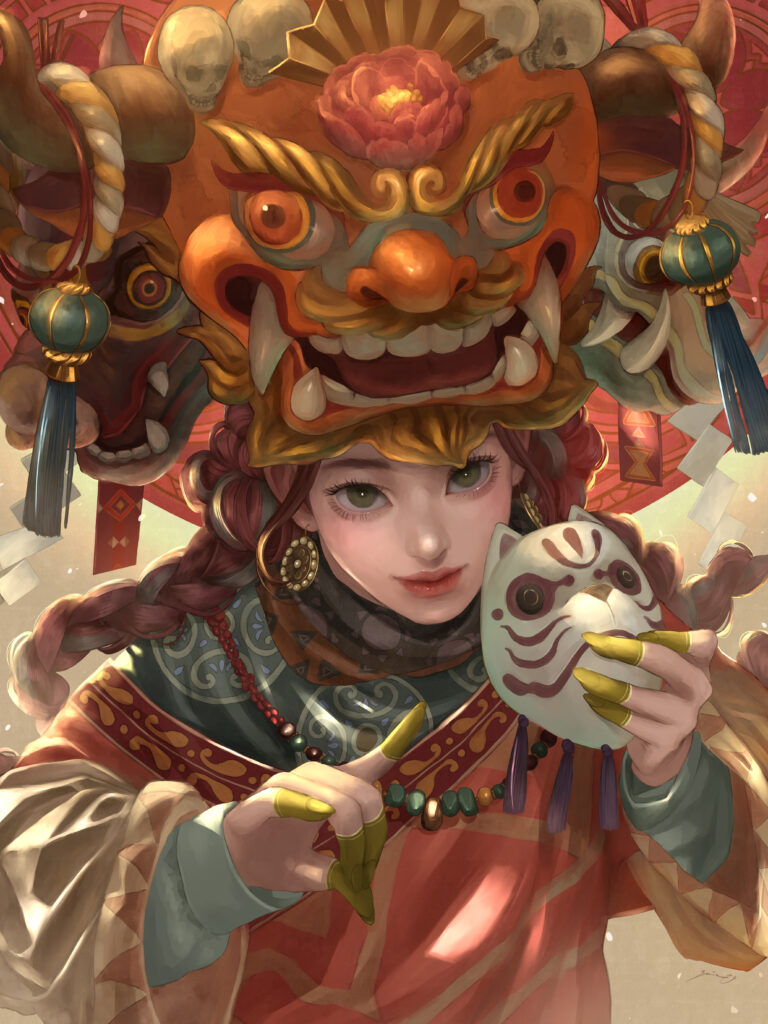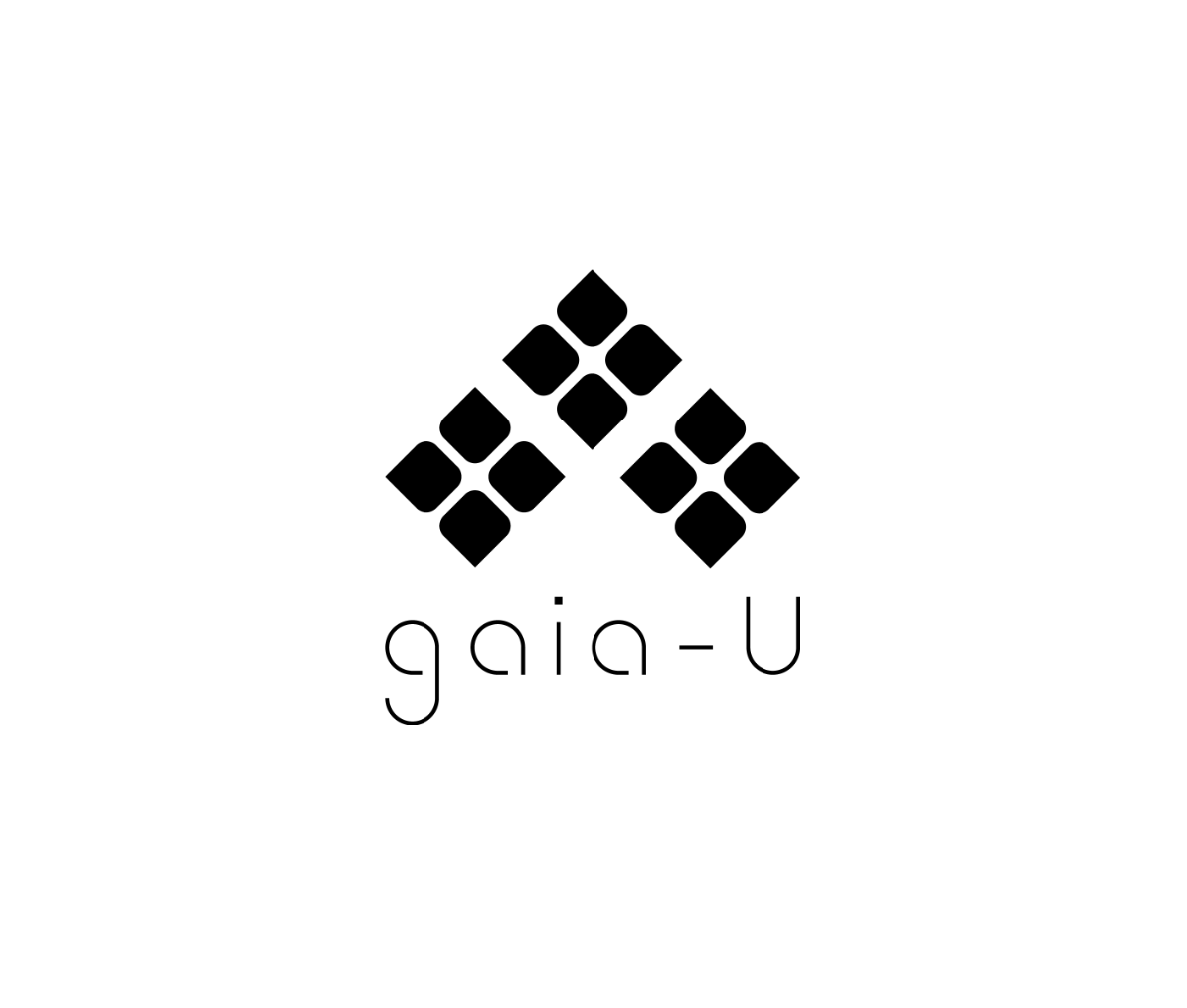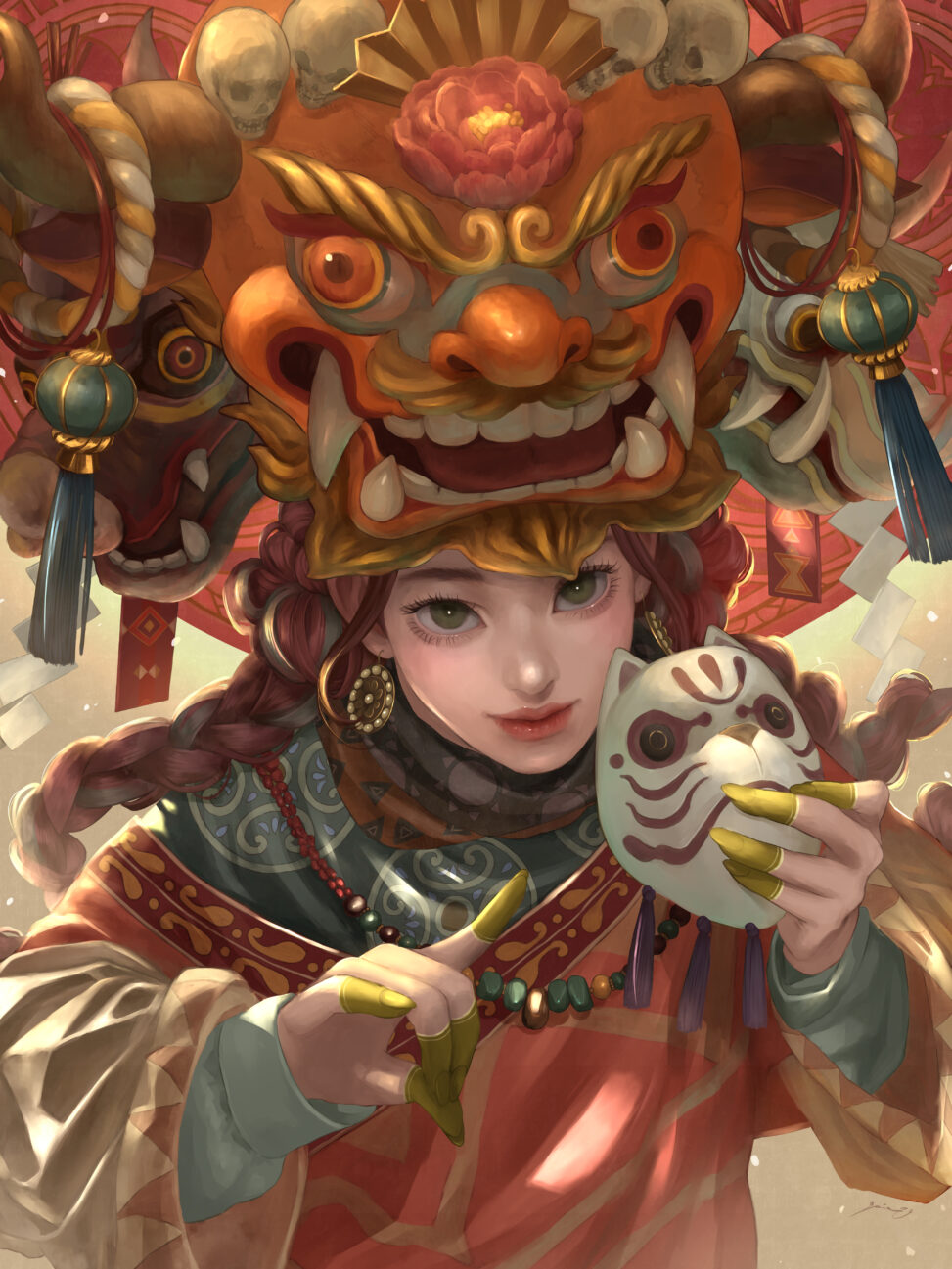
description
彼女の舞は 嵐の中に一筋の光が差すように力強く美しかった。
田畑は驚くほど生き返り、病もこの地から去っていった。
Her dance was powerful and beautiful, like a ray of light in a storm.
The fields came back to life in an amazing way, and the disease left the land.
あとがき
今回の作品はコミッションとなります。
モンゴルあたりの年末年始の華やかなものを、とのことでしたので
縁起の良い異国情緒あふれる一枚になるよう手掛けました。
一番目立つ真ん中の鬼面はチベットのものを参考にしており、髑髏は人間の5罪(貪欲・嫉妬・愚かさ・幼稚さ・欲情)に対する克服の象徴です。鬼は時として人に危害を加える「悪」として描かれることも多いですが、反対に「善」や神として崇められることもあり、多様的なものです。
あまり宗教的なものにはしたくないので、鬼面はかなりアレンジを加えて魔除けの意味合いを込めました。
後ろの2つの面は牛と猪で、牛は豊穣や生命力の象徴で、猪は無病息災を象徴しています。
牛は海外でも神聖視され、人が生まれながらに持つ善の心、すなわち慈悲の象徴とも考えられています。猪は優れた運動能力を持っているので戦場の護神として信仰されていたり、神の化身として古事記にも登場しています。
以上のように鬼面には魔除け、牛と猪には生命力や善心、無病息災の意味を込めました。
真ん中にいる女性は戦うように踊る挑戦的な踊り子を描きました。
舞や踊りの起源は神への祈りの一つの形であり、神と交流するためのものであったり、息災や調伏の儀式でもあります。
この女性の持つ狐面ですが、
中国では九尾の狐として妖艶で恐ろしい妖怪として描かれますが、チベットでは観音菩薩の化身として描かれていることがあります。日本でも稲荷神の使いであり、五穀豊穣のシンボルとなっていますね。
女性の表情は殷の妲己のような美女をモデルに、それでいて実りや息災を願うものにしました。
彼女の住む村は不幸に見舞われ、嵐で田畑が荒れ奇病が村人を襲ったのでしょう。
彼女が踊り始めると太鼓の音が鳴り響き、村人たちも次第に手を叩き、声を上げ、希望に包まれてゆきます。彼女の舞が五穀豊穣と平和をもたらすと信じられていたからです。
This work will be a commission.
The client asked for a festive piece for the year-end and New Year’s holidays in Mongolia.
I worked on it to make it an auspicious and exotic piece.
The most prominent ogre in the middle is a reference to the Tibetan one, and the skull is a symbol of overcoming the five sins of mankind (greed, jealousy, stupidity, childishness, and lust).ogre are often depicted as “evil” who sometimes harm people, but on the contrary, they are sometimes worshipped as “good” or gods, making them diverse.
Since I did not want to make it too religious, I rearranged the ogre masks quite a bit to include a sense of protection against evil.
The two masks in the back are a bull and a boar. The bull symbolizes fertility and vitality, while the boar symbolizes good health.
The bull is also considered sacred abroad and is considered a symbol of the goodness that people are born with, or mercy. Because of its superior athletic ability, the boar has been worshipped as a protective deity on the battlefield, and has also been mentioned in ancient articles as an incarnation of a deity.
As described above, the ogre masks are meant to ward off evil spirits, while the bull and boar symbolize vitality, good heart, and good health.
The woman in the middle depicts a challenging dancer who dances as if she is fighting.
Dances and dances originated as a form of prayer to the gods, either to communicate with them, to pray for good health, or to overcome evil.
This is a fox mask held by this woman, but in China
In China, it is depicted as a nine-tailed fox, a bewitching and terrifying specter, but in Tibet, it is sometimes depicted as an incarnation of Avalokitesvara Bodhisattva. In Japan, it is also a symbol of a good harvest, a messenger of the god Inari.
The woman’s expression was modeled after a beautiful woman like Shang’s Dakki, and with that, I made a wish for fruitfulness and good health.
The village where she lives has been struck by misfortune, perhaps a storm has ravaged the fields and a strange disease has struck the villagers.
When she began to dance, the sound of drums echoed and the villagers gradually clapped their hands, shouted, and became filled with hope. The villagers were filled with hope, for it was believed that her dance would bring them a bountiful harvest and peace.

